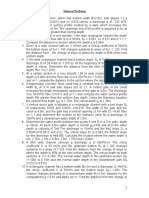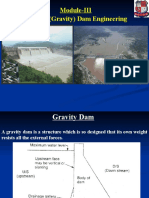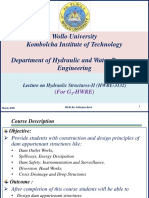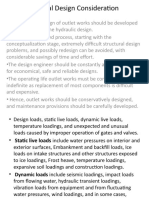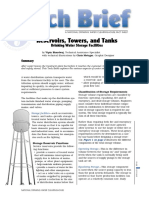Energy Dissipators-1
Energy Dissipators-1
Uploaded by
Mūssā Mūhābā ZēĒthiopiāCopyright:
Available Formats
Energy Dissipators-1
Energy Dissipators-1
Uploaded by
Mūssā Mūhābā ZēĒthiopiāOriginal Description:
Original Title
Copyright
Available Formats
Share this document
Did you find this document useful?
Is this content inappropriate?
Copyright:
Available Formats
Energy Dissipators-1
Energy Dissipators-1
Uploaded by
Mūssā Mūhābā ZēĒthiopiāCopyright:
Available Formats
HE/IE 732 DAM ENGINEERING III – APPURTENANT STRUCTURES
ENERGY DISSIPATORS
Energy Dissipators for Spillways
Einführung
Dissipation of the kinetic energy generated at the base of a spillway is essential for
bringing the flow into the downstream river to the normal—almost pre-dam—condition in
as short of a distance as possible. This is necessary, not only to protect the riverbed and
banks from erosion, but also to ensure that the dam itself and adjoining structures like
powerhouse, canal, etc. are not undermined by the high velocity turbulent flow.
Although a variety of devices are used for energy dissipation at the base of spillways,
the dissipation of energy is through internal friction and turbulence or impact and
diffusion of the high velocity flow in the mass of water. Devices and appurtenances
which aid the process of energy dissipation may also create peculiar problems that need
to be identified and solved.
Classification of Energy Dissipators
Energy dissipators for the spillways can be classified in several ways:
1. Based on hydraulic action: turbulence and internal friction as in hydraulic
jump stilling basins, roller buckets, and impact and pool diffusion as with ski
jump buckets and plunge pools.
2. Based on the mode of dissipation: horizontal as in the hydraulic jump, vertical
as with ski jump buckets/free jets, and oblique as with spatial and cross flows.
The vertical dissipation may be in the downward direction as with free jets
and plunge pools and in upward direction as with roller buckets.
3. Based on geometry or form of the main flow: situations involving sudden
expansion, contraction, counter acting flows, impact, etc.
4. Based on the geometry or form of the structure: stilling basin employs
hydraulic jump with or without appurtenances like chute blocks, baffle piers,
etc. Buckets (ski jump or flip buckets) include special shapes like serrated,
dentated buckets, and roller buckets that are either solid roller bucket or
slotted buckets.
Principal Types of Energy Dissipators
The energy dissipators for spillways can be grouped under the following five categories:
1. Hydraulic jump stilling basins
2. Free jets and trajectory buckets
3. Roller buckets
4. Dissipation by spatial hydraulic jump
5. Impact type energy dissipators
Hydraulic jump stilling basins include horizontal and sloping aprons and basins equipped
with energy dissipating appurtenances such as chute blocks, baffle piers, and dentated
end sills. This is the most common type of energy dissipator for the spillways and outlets
and effects up to 60% dissipation of the energy entering the basin, depending on the
Froude number of the flow. For heads exceeding about 100 m, hydraulic jump stilling
basins are not recommended because of the problems associated with turbulence like
intermittent cavitation, vibration, uplift, and hydrodynamic loading.
AMU, SGS - Lecture Note -1-
HE/IE 732 DAM ENGINEERING III – APPURTENANT STRUCTURES
Free jets and trajectory buckets are not dissipators of energy in real sense. The bucket
deflects the high velocity jet into the air and is made to strike the riverbed at a
considerable distance from the structure. Any scour that may occur in the impingement
zone remains away from the structure and hence does not endanger the stability of the
structure. Nappe splitters and dispersers contribute to the dissipation of energy by
spreading and aerating the jet. Nevertheless, at some projects, problems of spray and
retrogression of the scour hole towards the structure threatened the stability. Coupled
with the plunge pools, part of energy of the deflected jet can be dissipated by pool
diffusion.
Roller buckets can be conceptualized as hydraulic jump on a curved floor, as its
performance is closely related to the Froude number of the incoming flow and tail water
depth. It can also be seen as an economical alternative to the elaborate sloping aprons.
Solid roller bucket is a simple device that gives satisfactory performance provided it is
operated symmetrically. Asymmetrical operation results in a horizontal eddy downstream
of the bucket that can carry loose material into the bucket causing abrasion damage.
The slotted bucket, claimed to be an improvement over the solid bucket, has a self-
cleansing potential by way of slots and teeth in the bucket. In spite of this, as many
slotted buckets as solid roller buckets have been damaged due to abrasion and
cavitation. The performance of the slotted bucket is more sensitive to tail water variation
than that of the solid roller bucket.
The most common form of energy dissipator at the outlets of shaft/tunnel spillways is a
flip bucket. However, when topographical or geological conditions are not favorable, a
hydraulic jump stilling basin is the only choice regardless of concentration of discharge
and energy at the entrance to the energy dissipator. The standard design of stilling basin
would normally not be suitable.
Impact induced by an obstacle placed against the high velocity flow is also applied to
accomplish energy dissipation in small chutes and spillways. Since the successful
performance of such structures is dependent on the stability of the impact-inducing
obstacle against fluctuating drag force and cavitation damage, these designs have found
limited application for low heads and small discharges.
Besides, there are quite a few designs of unconventional types of energy dissipators
suited to the site-specific conditions. Recently stepped spillways that combine the
features of both the spillway and energy dissipator have become popular. These are
suitable for dams being constructed with roller compacted concrete (RCC) because of
the obvious advantage of steps being formed with placement of concrete in lifts of
required thickness. It offers dissipation of part of the energy on the spillway chute itself
and enables reduction in the size of the stilling basin; however, their use is limited up to
the unit discharge of 30 cumec/m in view of the apprehension about cavitation damage.
Selection of the Type of Energy Dissipator
The factors that govern the choice of the type are: hydraulic considerations, topography,
geology, type of the dam, layout of other associated structures, economic comparison,
frequency of usage, as well as special and environmental considerations.
Topography influences the type of the dissipator in the same way as it influences the
type of the dam or the spillway. The topography that favors the selection of a shaft
AMU, SGS - Lecture Note -2-
HE/IE 732 DAM ENGINEERING III – APPURTENANT STRUCTURES
spillway or a tunnel spillway will most likely be an ideal site for a flip bucket. Even for the
gravity or arch dams in steep and narrow canyons, ski jump buckets or flip buckets
would be more suitable, provided the problems of spray and resulting bank erosion and
land slides can be tackled. Ski jump buckets are found to be most suitable for dams to
be constructed in steep and narrow valleys where a power house would be
accommodated at the foot of the dam, with the roof of the power house, in the form of an
inverted circular arc, also serving as the ski jump bucket. On the other hand, hydraulic
jump stilling basin would prove to be more problematic, not only from consideration of
deficient tail water depth and longer training walls, but also due to the concern arising
from the falling of debris from the steep slopes into the stilling basin.
Flip buckets would be preferable also for the chute spillways located on flanks but in the
vicinity of the main river channel. While a hydraulic jump stilling basin along with the river
joining works would be inefficient and expensive, flip bucket with a deflector to divert the
jet towards the main river channel would result in a compact structure.
Hydraulic jump stilling basins and slotted buckets would be less preferable for the
spillways whose construction may continue for several years and where seasonal floods
have to be passed down the partly constructed spillways. Stilling basins for such
spillways are prone to be filled up intermittently and damaged due to impinging
concentrated flows, abrasion, etc. Similarly, for the spillways that serve dual functions,
such as flood and sediment disposal, stilling basins or roller buckets should be avoided
as far as possible, due to the possibility of abrasion damage caused by sediments
passing down the spillways during flushing operation.
Sometimes environmental factors play a decisive role in determining the type of the
energy dissipator. Erosion due to plunging jets and spray caused by the flows from ski
jump buckets adversely affect the river water quality by turbidity, harmful for the fish
population. When the tail water levels were too high to hinder the formation of a clear flip
action, a submerged hydraulic jump on a step followed by an apron was found to
perform satisfactory. Thus, the type or design of the energy dissipator has to be adapted
as demanded by the prevailing environment.
Analysis of Parameters
The problem of dissipation of energy at the base of a spillway can be visualized with
reference to the situation illustrated in Figure 1. This clearly shows the key parameters:
the height of the spillway (P), the specific discharge (q), the headwater representing the
initial energy (E0), and the tail water representing the energy level downstream (Et). Also,
----------------------------------------------------------(1)
----------------------------------------------------------(2)
where
y0 = Approach depth
yt = Tail water depth
V0= Approach velocity, and
Vt = Downstream velocity
AMU, SGS - Lecture Note -3-
HE/IE 732 DAM ENGINEERING III – APPURTENANT STRUCTURES
Figure 1 Key parameters in energy dissipation.
It would be seen that the difference between the upstream and downstream energies
(dE) is the energy that must be dissipated by the energy dissipator. A combination of the
four parameters would determine the type of flow condition at the base of the spillway,
namely an effective hydraulic jump, a sweeping or deficient jump, a submerged jump, a
diving jet, or a floating jet. As several combinations of parameters exist, a variety of flow
conditions at the base are possible. The latitude of the changes in parameters is limited;
only the headwater rating curve can be changed by altering the depth of overflow or
width of the spillway, resulting in the change of specific discharge q. The tail water rating
curve is imposed by nature and cannot be changed except with an artificial control in the
river downstream.
A preliminary indication as to the expected flow condition for the entire range of
discharge can be obtained by superimposing the jump-height curve on the tail water
rating curve. A jump-height curve is formed by adding the conjugate depth of hydraulic
jump, y2, to the assumed elevation of the apron (that can be constructed economically
on the bedrock available at the site) corresponding to various discharges.
Figure 2 shows four possible cases of relationships between the jump-height and tail
water rating curves.
The general guidelines are indicated in Table 1. Based on the dimensional analysis of
the parameters involved in the process, the following relationship is obtained
-------------------------------------------------------------------(3)
Which, in combination with the theoretical relationship for the hydraulic jump on a
horizontal floor can be used to perform similar analysis as in Figure 2.
-----------------------------------------------(4)
AMU, SGS - Lecture Note -4-
HE/IE 732 DAM ENGINEERING III – APPURTENANT STRUCTURES
Figure 2 Jump height and tail water rating curves.
AMU, SGS - Lecture Note -5-
HE/IE 732 DAM ENGINEERING III – APPURTENANT STRUCTURES
The curve representing Equation 3 is also called the characteristic curve, since this
curve combines the characteristics of both the headwater and tail water rating curves.
The diagram superimposing the characteristics curve on the theoretical curve (Eq. 4) is
called the fence diagram. Rudavsky analyzed results of several model studies in respect
of different types of energy dissipators and prepared fence diagrams that define the
range of applicability of various types of energy dissipators such as (a) hydraulic jump
stilling basin without baffle piers, (b) hydraulic jump stilling basins with baffle piers, (c)
solid roller buckets, (d) slotted bucket, and (e) deep-seated excavated stilling basin
called Smetana’s basin. The diagrams are shown in Figure 3. The curve (1) is the
theoretical relationship for hydraulic jump as given by Equation 4. The characteristics
curve for the specific spillway structure under consideration, given by Equation 3 should
be plotted on the same diagram. If the curve is contained within the shaded region called
application range, for a given type of energy dissipator [(a) to (e)], that type of energy
dissipator is adopted. Small adjustment in the position of the characteristics curve
relative to the theoretical curve (1) is possible by changing the depth of overflow/ width
of the spillway and hence q.
It must, however, be noted that diagrams such as Figure 2 and Figure 3 are not the
design charts. These may be used only as design aids in visualizing the possible flow
conditions at the toe of a spillway, as a result of the interaction between the relevant
parameters involved in the process of energy dissipation.
Illustrative Examples
Discuss the available alternatives of energy dissipation arrangement for a spillway with the
following details:
FRL El 677 m, crest El 662 m, width at toe 52 m, maximum Q= 5160 m3/s, specific
discharge q = 99.2 m3/s /m, and acceptable apron elevation El 605 m.
The spillway will be operated with reservoir at FRL, passing discharges lower than the
maximum discharge with partial opening of crest gates. The tail water rating curve is defined as
curve B in Figure 4.
Solution
Calculation of jump-height curve:
Conjugate depth y2 has been calculated as follows; q = 99.2 m3/s /m; E0 = 72 m = y0 (Head water
maintained by gate operation)
Similarly, values for other discharges have been calculated and shown in Table 2.
Figure 4 shows the jump-height curve (A) plotted superimposed on the tail water rating curve (B).
It also shows the fence diagram with the theoretical curve for hydraulic jump on horizontal floor,
curve (1) plotted superimposed on the characteristic curve (2). From the series of application
curves (Fig. 3), the one that fits in, at least partly, namely excavated basin with baffle piers (case
B), is also plotted there in. Analysis of the above indicates that:
AMU, SGS - Lecture Note -6-
HE/IE 732 DAM ENGINEERING III – APPURTENANT STRUCTURES
Figure 3. Application ranges of various energy dissipators (Rudavsky, 1976):
1) Application range, 2) Sweep out begins, 3) Theoretical curve.
1. Hydraulic jump will form on the apron proposed at El 605 m, for the discharges smaller than
3000 m3/s. For higher discharges, a deficient jump may form or sweep out condition may take
place.
2. From the series of fence diagrams indicating range of application of various types of energy
dissipators (Fig. 3), the one pertaining to the alternative of the excavated basin with baffle piers is
partly applicable and suggests a stilling basin with baffle piers for higher discharges. The lower
discharges (up to about 60% of the maximum discharge) however, are not covered by the
application range.
3. Incorporating baffle piers in flow velocities as high as 37 m/s is not advisable from
apprehension of cavitation. This alternative, therefore, cannot be pursued further.
AMU, SGS - Lecture Note -7-
HE/IE 732 DAM ENGINEERING III – APPURTENANT STRUCTURES
4. One may also consider altering the vertical position of the stilling basin, indicated by the
vertically shifted JH curves, A′ and A’’. The position A′ represents the stilling basin lowered by
about 5 m, making the entire JH curve below the TW curve, so that hydraulic jump forms for all
discharges. The curve A’’ is above the TW curve for all discharges and corresponds to a flip
bucket placed about 5 m higher than the elevation 605 m under consideration. Besides
ascertaining the suitability of submerged hydraulic jump for low discharges and competence of
rock in the downstream for a flip bucket proposal, increased cost due to excavation or concreting
also should be considered.
5. A design combining the features of hydraulic jump and flip bucket, i.e. a combination type
energy dissipator, functioning as hydraulic jump stilling basin for low discharges and flip bucket
for high discharges, as shown in Figure 4, may also be suitable.
A provisional decision in regard to the type of the energy dissipator should be based on
considerations of hydraulic performance, site conditions, and cost economics. The final design
could be evolved from model studies.
AMU, SGS - Lecture Note -8-
You might also like
- Chapter4 - Surface Irrigation NewDocument28 pagesChapter4 - Surface Irrigation NewMūssā Mūhābā ZēĒthiopiāNoch keine Bewertungen
- Headwork (Diversion Weir) Design - For AGP SSIP-by AberaChalaDocument49 pagesHeadwork (Diversion Weir) Design - For AGP SSIP-by AberaChalaAbera Chala100% (1)
- CH - 2.3 Buttress Dam PDFDocument35 pagesCH - 2.3 Buttress Dam PDFHadush TadesseNoch keine Bewertungen
- Wrie Iii Prepared By: Yassin Y. Dam Engineering II ExercisesDocument6 pagesWrie Iii Prepared By: Yassin Y. Dam Engineering II ExercisesWalterHu100% (1)
- A-Guide-to-Safe-and-Cost-Effective-Spillways - Peter Mason PDFDocument8 pagesA-Guide-to-Safe-and-Cost-Effective-Spillways - Peter Mason PDFFacundoNoch keine Bewertungen
- Chapter 4. Surface IrrigationDocument36 pagesChapter 4. Surface IrrigationMūssā Mūhābā ZēĒthiopiā100% (1)
- Chapter 5. Land LevellingDocument22 pagesChapter 5. Land LevellingMūssā Mūhābā ZēĒthiopiā100% (3)
- Chapter 3 (CWR)Document37 pagesChapter 3 (CWR)Mūssā Mūhābā ZēĒthiopiāNoch keine Bewertungen
- Chapter Four: Spillways & Energy DissipatorDocument84 pagesChapter Four: Spillways & Energy Dissipatorzelalemniguse100% (1)
- Optimum Design of Stilling Basin PDFDocument8 pagesOptimum Design of Stilling Basin PDFZiza LukovacNoch keine Bewertungen
- Arch DamDocument15 pagesArch DamHenok MandefroNoch keine Bewertungen
- G2.11 Reservoir PlanningDocument16 pagesG2.11 Reservoir PlanningJenny Moreno100% (2)
- Anley Assignment1Document19 pagesAnley Assignment1banitessew82100% (1)
- Chapter 4-Concrete Arch and Concrete Buttress DamsDocument10 pagesChapter 4-Concrete Arch and Concrete Buttress DamsMohamed Al-OdatNoch keine Bewertungen
- Open TutorialDocument2 pagesOpen Tutorialeph86% (7)
- Chapter 2 SpillwayDocument83 pagesChapter 2 SpillwayKaseye AmareNoch keine Bewertungen
- Types of Weir PDFDocument14 pagesTypes of Weir PDFRAKESH KUMAR 061Noch keine Bewertungen
- CH 5 Cross DrinageDocument40 pagesCH 5 Cross DrinageAbuye HDNoch keine Bewertungen
- Ce302 - Dhs Question BankDocument5 pagesCe302 - Dhs Question Banksyamak0% (1)
- Module-III Concrete (Gravity) Dam EngineeringDocument43 pagesModule-III Concrete (Gravity) Dam EngineeringMadan Mohan ReddyNoch keine Bewertungen
- Unit 1 - Canal DesignDocument75 pagesUnit 1 - Canal DesignAshwini Nair100% (1)
- Hydraulic Structure 1Document211 pagesHydraulic Structure 1tazebNoch keine Bewertungen
- Hydraulic Structure Module FINAL FinalDocument129 pagesHydraulic Structure Module FINAL FinalAnonymous K2s2woQ50% (2)
- Flood Routing HydrologyDocument69 pagesFlood Routing Hydrologytesh100% (1)
- MCQ Ahe U6Document3 pagesMCQ Ahe U6Abhijeeth Nagaraj100% (2)
- Ch-5 Spillways-5Document17 pagesCh-5 Spillways-5Fikir YoNoch keine Bewertungen
- Culvert BasicsDocument52 pagesCulvert BasicsXDXDXDNoch keine Bewertungen
- Transition For Small CanalsDocument50 pagesTransition For Small CanalsZac MwebNoch keine Bewertungen
- DAM Powerpoint 2023Document342 pagesDAM Powerpoint 2023degarege100% (1)
- Irriagtion Engineering Hydraulic Structures Santosh Kumar Garg 19 EditionDocument1,726 pagesIrriagtion Engineering Hydraulic Structures Santosh Kumar Garg 19 EditionZahid RahmanNoch keine Bewertungen
- Final Exam Dam Engineering 18-12-2020 PDFDocument11 pagesFinal Exam Dam Engineering 18-12-2020 PDFBaba ArslanNoch keine Bewertungen
- Hydraulic Design of STRAIGHT Drop Structures For Exit of TunnelDocument7 pagesHydraulic Design of STRAIGHT Drop Structures For Exit of TunnelOpata OpataNoch keine Bewertungen
- 19 1 PDFDocument6 pages19 1 PDFآكوجويNoch keine Bewertungen
- Canals 25072022Document44 pagesCanals 25072022Reiger RoyalNoch keine Bewertungen
- Open Channel Hydraulics Worksheet 2Document4 pagesOpen Channel Hydraulics Worksheet 2Yasin Mohammad Welasma100% (1)
- Chapter 4 Diversion Head WorksDocument30 pagesChapter 4 Diversion Head Worksloserboi10180% (15)
- Lecture 6 Arch - DamDocument25 pagesLecture 6 Arch - DamChanako DaneNoch keine Bewertungen
- Canal DesignDocument26 pagesCanal Designnibas999100% (3)
- Hydraulics IITDocument888 pagesHydraulics IITsharvan1063% (8)
- Shaft SpillwayDocument3 pagesShaft Spillwaybotch100% (3)
- Side Channel SpillwayDocument20 pagesSide Channel Spillwayreem.ranoom.moonNoch keine Bewertungen
- Lec 13, Discharge MeasurementDocument24 pagesLec 13, Discharge MeasurementWaqar KhanNoch keine Bewertungen
- Jimma University Engineering and Technology College Department of Water Resources & Environmental EngineeringDocument1 pageJimma University Engineering and Technology College Department of Water Resources & Environmental EngineeringRefisa JiruNoch keine Bewertungen
- The Broad Crested WeirDocument6 pagesThe Broad Crested WeirIshara CoorayNoch keine Bewertungen
- Hydraulic Structures Mod 4Document85 pagesHydraulic Structures Mod 4SiddiqueNoch keine Bewertungen
- Class Notes SpillwayDocument7 pagesClass Notes SpillwayIcegroup Coaching100% (1)
- Diversion Head Work: Prof. M.B Chougule DKTE' YCP IchalkaranjiDocument63 pagesDiversion Head Work: Prof. M.B Chougule DKTE' YCP Ichalkaranjishamsu100% (1)
- Lecturenote - 1628442650hs-II, Lecture On Ch-1Document35 pagesLecturenote - 1628442650hs-II, Lecture On Ch-1sent T100% (1)
- Chapter 5 Diversion Head WorksDocument58 pagesChapter 5 Diversion Head Worksbpiuyt123Noch keine Bewertungen
- CE404 03 Stilling BasinsDocument10 pagesCE404 03 Stilling BasinsAbhishek Shah100% (1)
- Assignment 2 Sediment - FinalDocument12 pagesAssignment 2 Sediment - FinalzelalemniguseNoch keine Bewertungen
- Mid Sem Question Paper DAMDocument1 pageMid Sem Question Paper DAMविश्वेश सिंह100% (1)
- Gravity and Non-Gravity WeirsDocument1 pageGravity and Non-Gravity WeirsDesktop NepalNoch keine Bewertungen
- Hydraulic Structure PPTSummer MaterialDocument397 pagesHydraulic Structure PPTSummer MaterialZelalem A.Noch keine Bewertungen
- Assignments-Design of Dam Appurtenant Structures-2022Document2 pagesAssignments-Design of Dam Appurtenant Structures-2022Marew Getie100% (2)
- CCHE2D Two Dimensional Hydrodynamic and Sediment Transport Model For Unsteady Open Channel Flows Over Loose Bed PDFDocument89 pagesCCHE2D Two Dimensional Hydrodynamic and Sediment Transport Model For Unsteady Open Channel Flows Over Loose Bed PDFBC ECNoch keine Bewertungen
- Unit 7 Diversion Head WorksDocument28 pagesUnit 7 Diversion Head WorksDEEPESH RAINoch keine Bewertungen
- Hydraulic Structure UNIT 1Document91 pagesHydraulic Structure UNIT 1rvkumar361969097% (32)
- A Guide To Safe and Cost Effective SpillwaysDocument8 pagesA Guide To Safe and Cost Effective SpillwaysdjajadjajaNoch keine Bewertungen
- Energy DissipatersDocument8 pagesEnergy DissipatersLeticia Karine Sanches BritoNoch keine Bewertungen
- Literature Review and Objectives of StudyDocument34 pagesLiterature Review and Objectives of Studyyaseen90azizNoch keine Bewertungen
- Critical Review of Stilling Basin Models For Pipe Outlet WorksDocument4 pagesCritical Review of Stilling Basin Models For Pipe Outlet WorksInternational Journal of Research in Engineering and TechnologyNoch keine Bewertungen
- Chapter 2Document35 pagesChapter 2Eba GetachewNoch keine Bewertungen
- Hydro Power PlantsDocument7 pagesHydro Power PlantsKyambadde Francisco100% (1)
- Energy Dissipation: Lecture #4Document8 pagesEnergy Dissipation: Lecture #4Mūssā Mūhābā ZēĒthiopiāNoch keine Bewertungen
- Chapter 2 Soil-Water-PlantDocument50 pagesChapter 2 Soil-Water-PlantMūssā Mūhābā ZēĒthiopiāNoch keine Bewertungen
- Spillways: Lecture #2 (Con'd)Document15 pagesSpillways: Lecture #2 (Con'd)Mūssā Mūhābā ZēĒthiopiāNoch keine Bewertungen
- Lecture #3 (Con't) : SpillwaysDocument11 pagesLecture #3 (Con't) : SpillwaysMūssā Mūhābā ZēĒthiopiāNoch keine Bewertungen
- Siphon SpillwaysDocument29 pagesSiphon SpillwaysMūssā Mūhābā ZēĒthiopiāNoch keine Bewertungen
- Oct. 2017 Arbaminch, EthiopiaDocument14 pagesOct. 2017 Arbaminch, EthiopiaMūssā Mūhābā ZēĒthiopiāNoch keine Bewertungen
- Spillway NOTEDocument74 pagesSpillway NOTEMūssā Mūhābā ZēĒthiopiāNoch keine Bewertungen
- Determination of Groundwater Potential in Asaba, Nigeria Using Surface Geoelectric SoundingDocument6 pagesDetermination of Groundwater Potential in Asaba, Nigeria Using Surface Geoelectric SoundingGodwin IwekaNoch keine Bewertungen
- Goulds 3175 Paper Stock / ProcessDocument1 pageGoulds 3175 Paper Stock / ProcessS DasNoch keine Bewertungen
- Soil Science Lab 5Document4 pagesSoil Science Lab 5Joshua Ruel NalzaroNoch keine Bewertungen
- Weir Dsign and LayoutDocument5 pagesWeir Dsign and LayoutBehar Abduraheman100% (1)
- CEA 4001 Sprinkler SystemsDocument156 pagesCEA 4001 Sprinkler SystemsVincent Moufflarge100% (3)
- Review On Defluoridation Techniques of Water: Piddennavar Renuka, Krishnappa PushpanjaliDocument9 pagesReview On Defluoridation Techniques of Water: Piddennavar Renuka, Krishnappa PushpanjaliSangram PhadtareNoch keine Bewertungen
- PDS Tahal Water and SanitationDocument2 pagesPDS Tahal Water and SanitationVivek GuptaNoch keine Bewertungen
- Connect (5 Plus) Final Revision Final 25-12-2023Document38 pagesConnect (5 Plus) Final Revision Final 25-12-2023montaser ibrahimNoch keine Bewertungen
- Alvenius Comparativo de Diametros Nominais e ExternosDocument1 pageAlvenius Comparativo de Diametros Nominais e ExternosAna Carolina AlvesNoch keine Bewertungen
- Sanitary Drainage SystemsDocument25 pagesSanitary Drainage Systemspepito manalotoNoch keine Bewertungen
- Water Resources Management in India-Challenges andDocument9 pagesWater Resources Management in India-Challenges andSuraj KambleNoch keine Bewertungen
- Rored HdaDocument52 pagesRored HdaJoshua MartonoNoch keine Bewertungen
- List of National Parks of India - Wikipedia, The Free EncyclopediaDocument6 pagesList of National Parks of India - Wikipedia, The Free EncyclopediaDarshan KanganeNoch keine Bewertungen
- Plastic Road PresentationDocument27 pagesPlastic Road PresentationRaaj ViraajNoch keine Bewertungen
- AFFF Foam Extinguisher MSDSDocument8 pagesAFFF Foam Extinguisher MSDSRidouane ElkharrakNoch keine Bewertungen
- Clarifier Sizing SpreadsheetDocument1 pageClarifier Sizing Spreadsheetarvin4dNoch keine Bewertungen
- Family Name: Pelosi 2. First Name: Alfonso: Curriculum VitaeDocument6 pagesFamily Name: Pelosi 2. First Name: Alfonso: Curriculum VitaeBonaventure NzeyimanaNoch keine Bewertungen
- Water Supply Design ManualDocument4 pagesWater Supply Design ManualAnguzu Olega BrevisNoch keine Bewertungen
- Water Supply Pipe Sizing Calculation For ApartmentsDocument2 pagesWater Supply Pipe Sizing Calculation For Apartmentsfebous100% (1)
- UPSC Maps QUESTIONSDocument12 pagesUPSC Maps QUESTIONSMohitNoch keine Bewertungen
- Chapter 1 EditedDocument3 pagesChapter 1 EditedBryan BardajeNoch keine Bewertungen
- BHARDWAJ and METZGAR 2001. Tech Brief - Reservoirs, Towers and TanksDocument4 pagesBHARDWAJ and METZGAR 2001. Tech Brief - Reservoirs, Towers and TanksmatiasregistroNoch keine Bewertungen
- Weight of SteelDocument73 pagesWeight of SteelGan Gan SaputraNoch keine Bewertungen
- Monitoring Pollution Level of The River KhiruDocument6 pagesMonitoring Pollution Level of The River KhiruNusrat Jahan RiteNoch keine Bewertungen
- AECOM TopProjects2017 EN WEB PDFDocument8 pagesAECOM TopProjects2017 EN WEB PDFMonish MNoch keine Bewertungen
- Geodiversity EVALUATION of GEODIVERSITY Srbija Stojanovic MijovicDocument12 pagesGeodiversity EVALUATION of GEODIVERSITY Srbija Stojanovic MijovicAnonymous TR7KLlARNoch keine Bewertungen
- Modelling The Adsorption of Iron and Manganese byDocument20 pagesModelling The Adsorption of Iron and Manganese byelisafan sjalomNoch keine Bewertungen
- Regional GeographyDocument4 pagesRegional Geographybaba abba habibNoch keine Bewertungen
- Day 1 Geology Part IiiDocument5 pagesDay 1 Geology Part IiiBonjovi VerdejoNoch keine Bewertungen
- Flood Is A Term Used To Denote An Enormous Amount of WaterDocument31 pagesFlood Is A Term Used To Denote An Enormous Amount of WaterMJ JessaNoch keine Bewertungen














